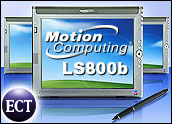
Let me set the record straight. I’ve never been a fan of tablet computers. If the urge to write on an LCD strikes me, I’ve always found my Palm Tungsten handheld sufficient for that desire. Nevertheless, when Motion Computing of Austin, Texas, introduced the LS800 tablet, it tantalized me.
For one thing, it’s a real tablet, not a laptop with a swiveling screen masquerading as a tablet. To my mind, it takes courage to totally cut the cord to the keyboard, as well as a bit of attitude that isn’t found in the PC industry these days outside of Apple.
For another thing, the unit is a nice size for writing. It’s slightly bigger than a moleskin diary — 6.7-by-0.9-by-8.9 inches — although much heavier at 2.2 pounds.
Comfortable Display
Its display is a comfortable size, too. At 8.5 inches, the LCD didn’t feel too cramped for text and Web work. I found the screen bright and sharp, but at maximum resolution — 800-by-600 pixels — text may be a wee tiny for some eyes.
It was also difficult to view the LCD in a less-than-vertical orientation. You can work with the screen in a horizontal position, but you have to position your head directly over the screen — not the greatest orientation for handwriting.
Unlike a handheld computer, where you navigate around the unit’s display with a stylus, the LS800 has a digital pen that performs like a mouse. A tap of the screen is the equivalent of a mouse click; two taps, a double click; holding the pen point to the screen simulates a right click.
You’ll be surprised how easy it is to make the transition from mouse to pen — especially if you’ve ever worked with a handheld computer — and maybe a little amazed. The LS800’s digital pen is a stylus on steroids.
Good Handwriting Recognition
The unit recognizes cursive handwriting and printing. You can also peck text through a pop-up soft keyboard on the display.
As an old hand with handwriting programs (do you remember the Apple Newton?), I can honestly say that Microsoft has done a good job with the scribbling recognition component of its Windows tablet operating system.
Unlike some portable computers, the LS800 includes a full working copy of Microsoft Office with it, not some 90-day trial version. Of course, applications like Word have been modified to accept handwriting input, but the alternations have been so seamlessly incorporated into the applicationsthat they feel native to the programs.
At the heart of the LS800 is a Pentium M processor running at 1.2 gigahertz. System performance was good, although the unit’s casing gets a tad warm after prolonged use.
Base units, which sell from US$1,833 to $1,946, include 512 megabytes of memory and a 30-gigabyte hard drive.
Bevy of Ports
For a system its size, the LS800 has a nice array of input and output devices.
It has a fingerprint reader and locking device keyhole for security. It also has two USB ports, a combination mic and headphone jack and an SD card slot. A monitor can be connected to the unit through its VGA socket.
The tablet has networking capability galore. It supports Bluetooth, WiFi and Ethernet.
In addition to its ports, the unit has a set of useful controls beside its display. There’s a five-way directional control — a sort of stick shift for quick screen movements like scrolling down a Web page –and buttons for rotating the screen from portrait to landscape and for calling up a dashboard that lets you customize aspects of the device.
If you work in an occupation where keyboards are persona non grata, but you want the power and functionality of a Windows-based computer, the LS800 is a tiny gem worth eyeballing.
John Mello is a freelance business and technology writer who can be reached at [email protected].





















































